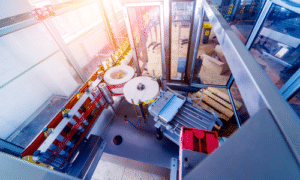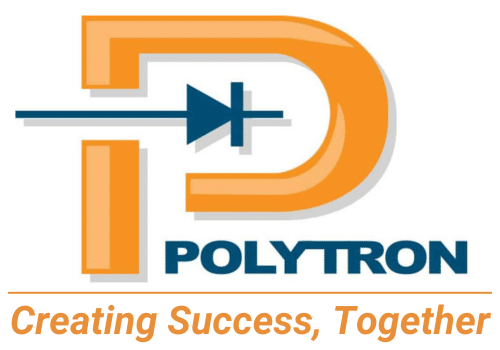When a global leader in the production and distribution of non-alcoholic beverages needed to meet new case labeling requirements, Polytron stepped in to plan for and install new GS1-128-compliant case labeling systems across 33 packaging lines without impacting quality, safety, or OEE.
Challenge |
Solution |
Results |
| To meet new regulatory requirements and help their large customers better track inventory, a leading global beverage manufacturer needed a partner who could seamlessly transition their traditional inkjet case labeling system for their chilled juice products to a more advanced print-and-apply case labeling system. | After carefully auditing all 33 packaging lines that needed the new print-and-apply case labelers, Polytron developed a detailed program management plan to deliver project management and turnkey installation of the new GS1-128 labeling systems across all sites over a period of 36 months.
The design and execution of all the demolition and install required for each system needed to be as delivered with seamless integration of the facilities’ planned downtime schedule and no impact to the facilities’ quality and OEE metrics. |
Over the course of three years, Polytron installed case labelers on 33 fresh chilled juice product lines. Our project team significantly reduced the risks involved with this large, geographically dispersed project, and all systems were installed to specification, with no impact to quality, safety, or OEE. |
The Project

As a global leader in the production and distribution of non-alcoholic beverages, product safety is paramount. Therefore, as more stringent regulations were implemented in the US under the Food Safety and Modernization Act, especially around traceability, this beverage manufacturer made the decision to upgrade the bundle and case labeling system for all their chilled juice production lines.
After testing several options internally, the manufacturer selected a print-and-apply case labeling system from Markem-Imaje that was capable of printing and applying GS1-128-compliant labels at the necessary rates. The key objectives for this change were to reduce clarity issues caused by inkjet printing and to enhance traceability by incorporating more information into their barcodes using the GS1-128 labeling standard. They also knew this new labeling scheme would be welcomed by some of their larger customers and distributors as it would help them better manage inventory.
However, adding the new labelers to each line was not going to be as simple as swapping the inkjet printers for the new print-and-apply systems; it would instead take a lot of effort and coordination. Since they could not risk significant downtime or slowing production, they wanted to find an integration partner familiar with the industry that could provide program management and turnkey installation services while minimizing any impact of the new labeling equipment on operational quality, safety, and efficiency. Polytron was selected to execute this program by the manufacturer’s management based on our long history of delivering successful projects and a trusted relationship with the client’s engineering team that allowed us to manage the entire program and free up their engineering resources for other corporate initiatives.
Our Process
Carefully Evaluating the Needs of Each Production Line
This project involved adding the new print-and-apply case labelers to 33 packaging lines in eight facilities located across five states. The manufacturer’s corporate engineering team made it clear that the new labelers could not become a bottleneck that would negatively impact their overall equipment effectiveness (OEE) or plant safety metrics.
To be sure we met these requirements, our team first visited each facility to audit every line – evaluating the unique processes and configurations used and taking measurements to understand the available space. Also, since this beverage manufacturer strategically provides each site with a lot of autonomy, our team met with the key stakeholders from operations, maintenance, engineering, and quality at each facility to understand their primary concerns for this update too.
As part of our audit phase, our team discovered we would need to reconfigure or replace conveyors for some lines to allow for enough separation between bundles or cases both before and after the new print and apply case labelers. Our team also identified some other unique site challenges to take into consideration. For instance, one site had conveyors located in a mezzanine. At another site in California, our team had to avoid altering the structure so that additional structural engineering to comply with local earthquake standards was not required.
After developing a clear understanding of the needs at each site and requirements for every line, we developed a comprehensive plan for integrating the new labelers and provided pricing for performing a turnkey installation. Our goal was to give the manufacturer a true picture of what the project would entail upfront, so our package also included bids from mechanical and electrical installers and structural engineers as needed. They not only approved the plan, but they also gave our team a lot of flexibility to do what was necessary to ensure the case labelers were properly installed, could meet the standards they had previously tested them to during their evaluation phase, and would not impact OEE.
Managing a Complex Turnkey Project from Start to Finish
From the beginning, this beverage manufacturer made it clear they wanted a partner that could manage every aspect of the project, and we knew our highly experienced project managers and engineers could deliver on that requirement. We leveraged our proven project management methodology and coordinated the many pieces of this project with Markem-Imaje and all the contractors and other vendors needed to perform the work in each plant. To add to the complexity of this large and geographically dispersed project, our team also had to manage through the challenges of the COVID-19 pandemic, including supply chain issues and site access restrictions to non-essential personnel. But we handled all the curveballs thrown our way and made this a seamless process for the manufacturer.
To execute this program, we worked with each facility to meticulously plan out a schedule that would not substantially interrupt production. In some cases, it was possible to leverage planned downtime for other work, and in other cases we were able to coordinate longer shifts or schedule work over a holiday weekend to get the equipment installed with minimal interruption.
After the necessary changes were made at a site and the new labelers were installed on the line, the next step was ensuring the labelers passed a strict site acceptance test (SAT) that the manufacturer had already negotiated with Markem-Imaje. The SAT criteria was well defined – either a run of 10,000 defect-free cases or eight hours running with 100 percent uptime had to be completed. Our team oversaw the commissioning of each system and worked together with Markem-Imaje on the SAT for each line. If a problem occurred, we worked closely with their team to resolve the issue quickly. Upon wrapping up at each facility we provided final drawings, closing out the end-to-end management of this project.
The Polytron Project Management Advantage
Over the course of three years, our team successfully managed all aspects of installing the new print-and-apply labelers on 33 fresh chilled juice product lines. This was an extremely complex program with a lot of scheduling and logistics to manage, but our highly experienced project team took on the task and delivered continuity across all project sites. Plus, with decades of experience executing projects for food and beverage manufacturers, our team had the technical expertise in house to design and implement any equipment or process changes needed to ensure each labeler would function as intended.
Overall, we helped this beverage manufacturer significantly reduce the risk of tackling this large, technically challenging, geographically dispersed program, and all systems were installed to specification, with no impact to their operations quality, safety, or OEE – which were their key concerns when this project began.




